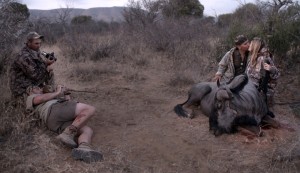I missed Trophy at Sundance, so I was glad for the chance to screen it at SXSW. It could be one of the better documentaries of the year (releasing widely later this Summer). Focusing on big game hunters/hunting, it also speaks to our global economical, political, spiritual, and environmental crises. Thankfully, it’s not simply a scathing critique of a niche market, but rather a complex take on a host of divisive topics that makes for one of the more complex and frustrating films of the year.
You could easily draw a line between two types of people, environmentalists and those that don’t give a shit, but life is more complicated than that and the new documentary, Trophy, revels in that tension. It focuses much of its attention on people like John Hume, businessman conservationists that raise and breed endangered animals for both preservation and profit. They claim to simultaneously increase the population of endangered animals whike providing hunters (largely from the United States and Canada) with their much-sought-after prey. Environmentalist Craig Packer admits that they are restoring a balance to the ecosystems that humans had decimated in previous decades. Hume and others like him also argue that their work leads to a decrease in illegal poaching, especially when governments pprohibit the trade of rhino horns, for example. Hume spends millions of dollars to guard his herd and even more money to protect four tons of horn valued at around $60 million.

Trophy also looks at the boots on the ground, and men like Chris Moore, who are leading anti-poaching campaigns. Moore tears up as he talks about being forced to kill an endangered animal to preserve the health and well-being of a vulnerable community. He is less bothered—it seems—by the death of a poacher.
The most fascinating—and frustrating—part of the film is Texan Philip Glass, who wants to kill the “Big 5” (buffalo, lion, elephant, rhino, and leopard). He’s an avid hunter, and the film opens with him taking his son to kill his first deer. But he is clearly traumatized by childhood experiences of his father forcing him to kill animals at random. He spins this on a positive note: his dad would be proud that he’s now hunting a lion. Although baiting and lying in wait seems a little one-sided. He—good Texan that he is—refers to God granting Adam and Eve dominion over creation as justification to do whatever he wants. One wishes these hunters had as much regard for Biblical translation and interpretation as they do for the caliber of their weapons and hunting permits.
Trophy is beautifully shot, and the vulnerability of their subjects speaks volumes about the filmmakers’ measured approach to the story. One thing is painfully clear, however, and that’s the “me and mine” mentality of this very small percentage of human beings that can actually afford to go on these hunting trips that is ruining the world for the rest of us.